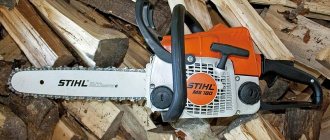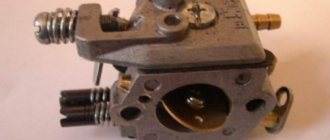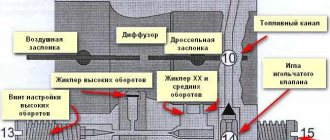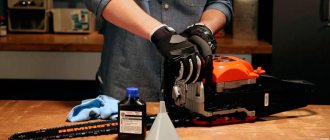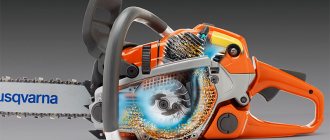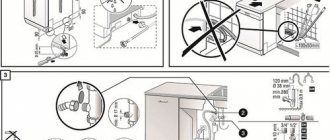Cleaning a chainsaw carburetor any modification, configuration and power follows one traditional and correct scheme, and its need arises as a result of clogging of the part. To understand that it’s time to clean the carburetor, you can observe how the saw starts up and immediately stalls, perhaps still “puffing”, making sounds trying to get the desired speed. One way or another, cleaning the carb with your own hands is quite possible, because our specialists provided instructions and demonstrated a video on how to do it quickly and correctly. Regarding proper cleaning, here we are talking not only about the use of certain products and liquids, but also about the format of purging, putting the carburetor back together, and also checking its readiness for future work.
Sometimes spare parts for a chainsaw do not need repair and cleaning, but timely replacement. Therefore, while your carb can still be cleaned and returned to its original working condition, take the advice from KosiKos and let your mechanism be healthy!
What carburetors are used on Chinese chainsaws
The most optimal carburetor designs for chainsaws were developed by the world's leading manufacturers - German Stihl, Japanese Walbro and others. These top developments are hard to beat. Therefore, most Chinese manufacturers copy the best models.
Today there is a large offer of Chinese carburetors for chainsaws on sale.
Some are nameless, from an unknown manufacturer and do not even have markings. They are simply offered for a specific chainsaw model. For example, a carburetor for a Stihl MS 361 chainsaw.
Others have brand names of well-known brands.
Still others have their own catchy names - in Russian transcription King Kong, Technopark, Rezet and others.
Carburetor chain malfunction
Remove the carburetor from the chainsaw. Remove the fuel pump cover using the diaphragm by unscrewing one screw in the center of the cover. Then turn the carburetor towards you using the throttle body, on the side where there are two holes, one pin is visible, there is an accelerator pump underneath it. Remove the retaining ring from the outside of the pin and disconnect the wire spring choke. Unscrew the screw in the center of the throttle body, remember how the throttle is installed (and then put it down) and remove the throttle. Pin hole (the accelerator is spring loaded and if you pull the throttle shaft out and don't close the hole the accelerator will pop up), then rotate the throttle shaft and remove it. Shake the accelerator (piston) out of the hole with a spring. There is a rubber seal (ring) on the piston. its wear is what causes the chainsaw to malfunction. rubber cuff and spring (they are sold as a repair kit). Or you can remove the worn piston with spring and plug the hole by hammering in a rubber plug (the chainsaw will be without an accelerating pump, i.e. it will not accelerate for 3 seconds, but for 4 seconds, but it will work well because it will not intake air carburetor).
Assembly after repairing a chainsaw malfunction (after removing a carburetor chainsaw malfunction) is performed in the reverse order of disassembly. When assembling the throttle body, before screwing in the screw, the throttle body must be properly positioned so that it does not stick, and screw the throttle body screw onto the axle, degrease and spread with a special thread sealant (sold in small pipes, red, liquid) or pliers because, If this bolt comes out during operation, it goes directly into the cylinder) and repair or replacement of the piston cannot be avoided). Therefore, we looked at troubleshooting this chainsaw problem.
Features of the Chinese chainsaw carburetor
Their design and parameters differ depending on the power and model of chainsaw they are intended for. All of them are almost identical to the original carburetors in design, but not always in quality. Today, all Chinese products cannot be considered 100% rubbish. In turn, according to their quality, they can be divided into three groups:
- Poor quality. Unsuitable alloys are used which oxidize, crumble and break. There is no accuracy of fit, the calibrated holes do not correspond to the required values, which leads to excessive consumption or lack of fuel in the combustion chamber. Critical parts quickly fail. Plastic parts quickly become rough or, conversely, become softened by gasoline and stop working. The axles and wire rods are bent, the threads of the fasteners are torn off. Such products are the cheapest. They are made in semi-handicraft industries using adapted equipment. As a rule, they do not have a name or marking.
- Carburetors are of average quality. These are factory assembled products. They do not skimp on alloys; they have established continuous production with quality control. These are fully functional carburetors that can have a service life even longer than that of the entire chainsaw.
- High quality carburetors. First of all, these are products from global manufacturers whose facilities are located in China. Geographically, they can be considered Chinese, but they are made using the technologies of the company that owns the brand and values its reputation. For example, Japanese Walbro carburetors are produced in China.
In addition, among Chinese manufacturers there are those who rely on high quality. They invest heavily in powerful production facilities, register their own brand and work on its reputation.
Step-by-step disassembly instructions
The carburetor design of models of different brands is almost identical, so let’s take the Partner chainsaw as an example. Each item is carefully removed and folded to make it easier to assemble later.
Chain carburetors from different manufacturers, if they differ, it does not matter
Remove the top cover by unscrewing the three bolts. This is followed by foam rubber, an integral part of the air filter.
The arrows indicate the bolts that need to be unscrewed to remove the cover.
Then remove the fuel hose and then the drive rod.
The top arrow points to the fuel hose, the bottom arrow to the drive.
Next, remove the cable lug.
The arrow indicates the end of the cable that needs to be removed.
To the left of the fitting, tighten the gas hose.
Also carefully remove the gas hose indicated by the arrow
The carburetor is permanently disconnected and is ready for adjustment. Its mechanism is quite complex, so if you need to further disassemble the carburetor, the elements should be removed very carefully - they are small so that they can be lost.
The carburetor consists of many small parts that must be arranged in order during disassembly.
Adjusting the carburetor of a Chinese chainsaw with your own hands
Adjustment is not provided on all carburetors of Chinese chainsaws. Today there are many models of household chainsaws, including European brands, whose carburetors simply do not have adjusting screws. Or there is only one idle speed adjustment screw.
Such carburetors require adjustment only when the chainsaw at idle makes too few emissions (revolutions) and sometimes stalls. Below in the text we will discuss the algorithm for adjusting the idle speed of the carburetor on a Chinese chainsaw.
Required Tools
Adjustment requires a screwdriver that fits the slots of the adjustment screws. On different carburetors they are flat, cross-shaped, with an internal or external hexagon, an asterisk, etc.
An electronic tachometer will help with adjustment. If it is not there, adjustment is carried out by ear and by assessing the actual operation of the engine.
Carburetor adjustment algorithm
Before making adjustments, make sure it is necessary. All Chinese carburetors on each chainsaw undergo factory settings, which rarely go wrong. A new carburetor, or in rare cases an old one, may require adjustment.
The cause of deterioration in engine performance with symptoms similar to poor supply of the fuel mixture is, in most cases, the following:
- clogged air filter,
- exhaust windows and muffler clogged with carbon deposits,
- bad fuel.
If this is not the problem, then try adjusting the carburetor.
The engine must be warm. A cold engine and one warmed up to operating temperatures operate differently. Therefore, adjustment in cold conditions will be incorrect.
- Provide access to the adjusting screws. On some chainsaws, it is enough to remove the cover and air cleaner. On others you have to remove part of the body. On the third, the housing has holes for a screwdriver.
- The screws are marked on the carburetor or near the holes - T (or LA) L and H. The T (or LA) screw is designed to adjust the idle speed. Always located away from screws L and H, which are next to each other.
- If the chainsaw stalls when gas is supplied, the engine does not have enough fuel to develop speed. The amount of fuel is adjusted using screw H (main screw). Unscrew it 1/4 turn and give gas. If the engine begins to work better, unscrew it another 1/4 turn. (If worse, then tighten it 1/4 turn in the opposite direction).
- If the engine starts to idle, it means there is a lot of fuel, screw H is screwed back.
- The peak speed is controlled by ear or using a tachometer. The maximum speed for each chainsaw is indicated in the instructions. (10,000 – 12,500 rpm). In practice, 10,000 – 11,000 rpm in the “full throttle” position are normal values.
- By increasing the amount of fuel supplied with screw H, the quality of the fuel mixture is adjusted with screw L. It increases and decreases the amount of air in the mixture. If there is not enough air, the fuel will not burn out; as a result, the engine smokes, does not develop power and consumes excess fuel. Screw L also affects engine operation at low and medium speeds.
- After adjusting screw H, screw L is unscrewed 1/4 turn. If there is smoke in the exhaust and the engine moves from low to medium and high speeds with dips, screw L is unscrewed some more.
- Adjustment of screw L is stopped when the engine runs smoothly, moves smoothly from low to high speeds and does not smoke.
After adjusting the two main screws, it is most often necessary to adjust the idle speed with the third screw.
The location of the adjusting screws is highlighted with a red square. To access them, a screwdriver is enough. There is no need to disassemble anything.
Idle speed adjustment
Idle speed adjustment sequence:
- The engine is started and warmed up for 5-7 minutes.
- The screw is unscrewed, increasing the speed until the chain begins to rotate.
- Then the screw is screwed back 1/4 turn.
If you have an electronic tachometer, you need to use its readings when making adjustments. Most chainsaws should idle at 2500 rpm.
Nuances that arise in the process
Screw L should not be unscrewed too much relative to screw H. This will lead to the formation of a lean air-fuel mixture (not enough gasoline - too much air). With such a mixture, the piston is dry during operation, gets very hot and can fail.
The factory Chinese carburetor, which comes with the chainsaw, is configured on the benches taking into account the characteristics of each chainsaw. Therefore, any change in the position of the screws during adjustment must be remembered or recorded in order to be able to return to the factory settings if the engine does not start.
New carburetors on Chinese chainsaws, sold separately, are adjusted at the factories to a standard number of revolutions or arbitrarily. Therefore, they may require adjustment after installation on the chainsaw.
Adjustment video
The author of the video shows the process of adjusting a classic Chinese chainsaw with a power of 2.8 kW and a working volume of 45 cubic meters. see. The author talks in detail about all the stages of setup, what screws are there, what they are responsible for and how to adjust them correctly. The whole process takes place without removing the carburetor itself from the chainsaw.
Methods and features of repairing fuel equipment
The cost of repairing a chainsaw carburetor may vary. The cost depends on the degree of destruction and type of problem. Sometimes it is enough for a service center specialist to simply turn the adjusting screw several times to obtain optimal operation of the fuel mixture supply system. But in most cases, installation of a repair kit and fine tuning will be required.
It is produced in several stages:
a specialist diagnoses the saw in a calm and working state and identifies problems;
protective covers are removed, the carburetor systems are inspected for damage;
new parts are installed, filters are changed, speed is set;
operation at idle and under load is checked for stable service.
It is worthwhile to repair a chainsaw in a workshop. In this case, the technician will have at hand all the necessary tools and spare parts to restore the equipment. Adjustment can be understood as a simple adjustment of engine speed, or a complex set of repair services. The cost of the service will depend on this.
Chinese chainsaw carburetor repair
Carburetors cost 500-1000 rubles. It doesn't always make sense to repair. A repair kit with a set of gaskets and a diaphragm costs not much less than the cheapest carburetor, 300-350 rubles. A frequent breakdown of Chinese carburetors is the failure of the injector valve, and such a part is not sold in repair kits. Therefore, it is easier to buy a new carburetor.
But there are breakdowns that can be relatively easily fixed on your own:
Loss of seal between parts of the carburetor body or between the carburetor and the engine. Sometimes it is enough to tighten the fastening screws. In other cases, you can remove the carburetor, replace the gaskets, or use a suitable sealant along with them.
Obvious mechanical problems - deformation of the wire rod from the throttle, sticking of the axes on which the throttle and air dampers rotate - are also easy to fix. The thrusts are straightened. The axle landing sites are lubricated with a drop of oil and free rotation is developed by hand.
Carburetor cleaning
The carburetor air filter needs to be cleaned periodically. They come in different types. From some it is enough to knock out dust and dirt by knocking on wood. Others are washed with soapy water. Still others require disassembly. The fourth ones are almost impossible to clean; they need to be replaced with a new one.
The features of the air filter for each chainsaw and maintenance rules are described in the instruction manual for each specific model.
If there is a filter in the gas tank, nothing can become clogged in the carburetor. If there is still a suspicion that the tiny holes in the jet are clogged, the carburetor is disassembled. The parts are laid out on a clean cloth, remembering which one comes from where. The holes are purged with a pump or compressor. The body and parts are washed in kerosene or gasoline.
There is no need to bring the condition of the filters to such a deplorable state. This greatly affects the performance and life of the chainsaw engine.
Gasoline does not flow into the carburetor: what to do
The fuel line from the gas tank is short and uncomplicated. Three problems may arise in this area:
- The gasoline supply hose is pinched. The break is found, the hose is straightened or replaced if the round shape is not restored.
- The filter at the bottom of the gas tank, which is installed on some models of chainsaws, is clogged. It is removed with a thin wire hook, inspected and cleaned. The gas tank is flushed with gasoline.
- The breather has failed. When fuel is sucked in, a vacuum is created in the gas tank, and fuel flows poorly or does not flow at all. This part cannot be repaired. Most often, the breather is located in a hard-to-reach place, at the outlet of the fuel line from the gas tank. It is replaced with a new one.
Sometimes, instead of repairing the breather, a hole with a diameter of 0.2-0.5 mm is made in the gas tank cap. The downside is that gasoline may leak through the hole during operation, and after operation the chainsaw can only be placed on its side, with the gas tank cap facing up.
How are things going with repair kits?
The repair kit can be purchased at the same retail outlets where carburetors are sold. They are sold in two configurations:
- rubber-plastic parts (gaskets, diaphragm)
- the same thing, plus a cross with a needle valve.
It is difficult to find other spare parts separately.
The principle of operation of a carburetor chainsaw
Before setting up a carburetor on a chainsaw, you need to understand the principle by which it works.
- When the engine starts, an air damper located at the bottom of the housing opens.
- As a result of the action of the piston, a vacuum is created in the air channel and the float chamber, as a result of which the air flow is sucked through the diffuser.
- The suction speed of the air flow is controlled by the position of the air damper.
- Gasoline enters the float chamber through the intake manifold from the fuel tank.
- The speed of passage of gasoline from the chamber into the diffuser is controlled by nozzles.
- In the diffuser, gasoline is mixed with air.
- The prepared air-fuel mixture enters the intake channels, from where it is directed into the working combustion chamber of the cylinder.
Pros and cons of Chinese carburetors
Chinese carburetors can be of low, medium and high quality. Low quality products have the advantage of extremely low prices. The best option in terms of price-quality ratio is, as a rule, in the middle price segment.
An original European-assembled Stihl carburetor or a purely Japanese Walbro carburetor are excellent in quality. But their cost is sometimes equal to the price of an entire Chinese chainsaw. Therefore, it is better to confidently navigate the wide variety of Chinese carburetors with which our market is flooded, and make an appropriate choice.
Features of washing in an ultrasonic bath
If you are wondering how to flush a chainsaw carburetor without disassembling it, then there is only one answer - nothing. An ultrasonic bath is also useless in this case, since during the cleaning process it is necessary to ensure the free removal of contaminants from the channels. If the carburetor is not disassembled, then these contaminants simply will have nowhere to go, and the result of such cleaning will simply be useless.
Some owners of gas-powered tools are looking for various flushing fluids and additives to the fuel mixture, hoping for their effectiveness. All these preparations and concentrates are simply useless, and if you really want to perform highly effective carburetor cleaning, then you should use a special ultrasonic bath. Even if your neighbor has convinced you of the effectiveness of such concentrates, then imagine the picture when all the contaminants enter the cylinder. Naturally, this will not lead to anything good, and as a result. Soon you will need to disassemble and repair or replace the internal combustion engine.
Ultrasound channel cleaning is the most effective, but even taking this factor into account, it is not possible to talk about complete restoration. It all depends on the extent of the clogging of the mechanism.
In addition, you must thoroughly know how to perform this procedure correctly. In particular, it is necessary to calculate the rinsing time as well as the temperature. The principle of washing a chainsaw carburetor in an ultrasonic bath is as follows:
- Remove the carburetor from the chainsaw and disassemble it
- It is necessary to disassemble the carburetor in order to ensure deeper penetration of the cleaning fluid into the channels
- The container fits the carburetor, except for small parts and rubber membranes
- You need to pour a special Ultra Red liquid into the container, which mixes with water
- Turn on the installation for the appropriate period of time 10-15 minutes
After completing the procedure, you will need to blow out the channels with compressed air, but carefully. After this, evaluate the quality of the flushing, and only after that assemble the mechanism.
